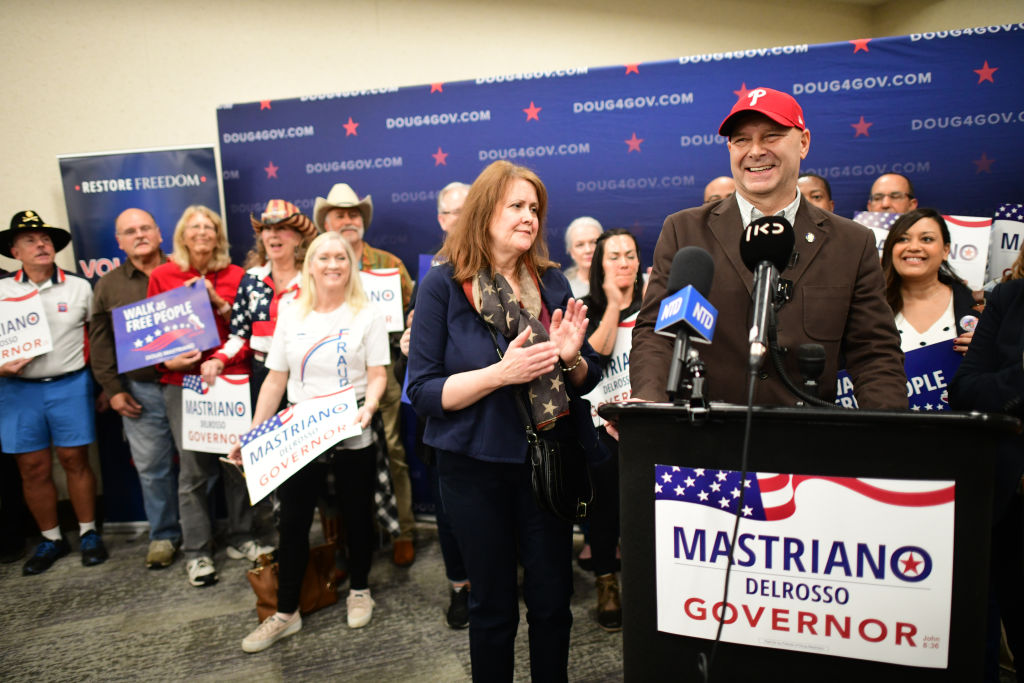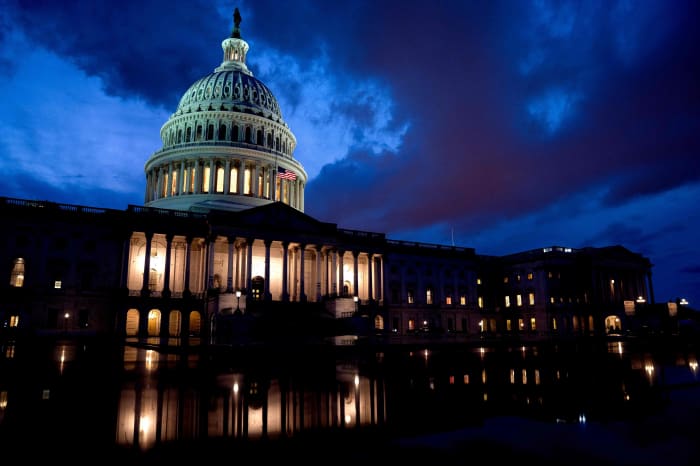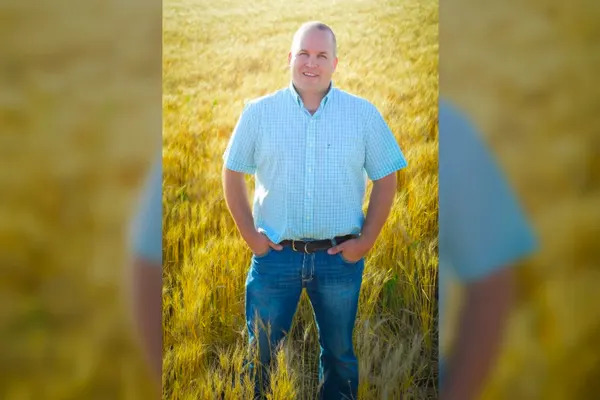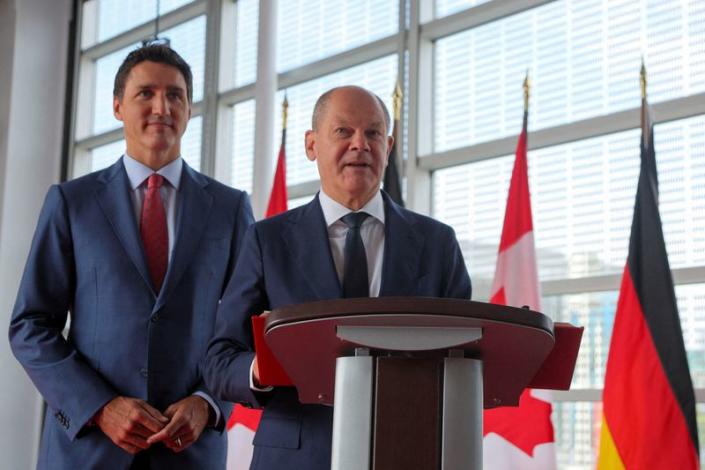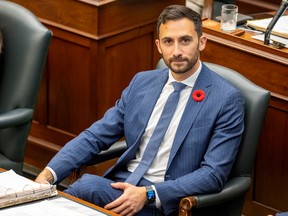Schools shut as 55,000 education workers strike in Canada's Ontario
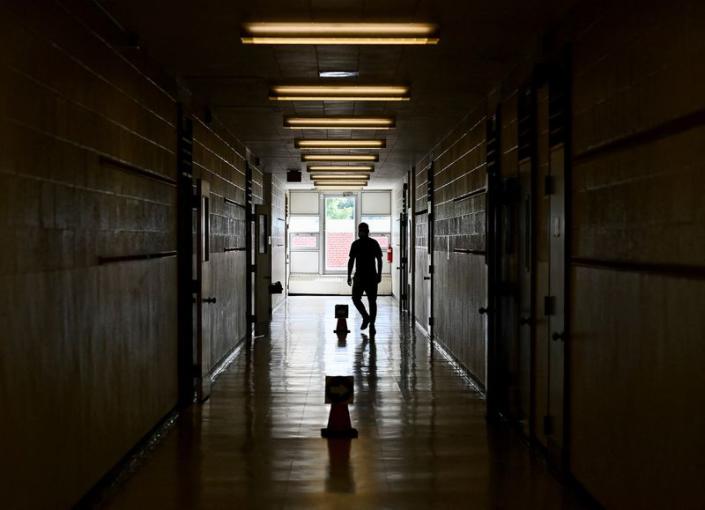
A teacher walks the divided hallways at Hunter's Glen Junior Public School in Scarborough
Fri, November 4, 2022
OTTAWA (Reuters) - Some 55,000 education workers went on strike on Friday in Canada's most populous province of Ontario after failing to reach an agreement with the provincial government for better pay and more frontline staff in schools.
The workers, which include educational assistants, secretaries and library workers, served a notice of strike on Sunday saying they had been unsuccessful in negotiating a new contract with the Doug Ford-led Ontario government.
In anticipation of the strike, school boards in Toronto and Ottawa notified parents that schools would be shut for in-person learning on Friday, and that students would need to work independently at home.
Ford's Progressive Conservative government says the workers' demands are too high and has passed a controversial law to force a contract on the workers represented by the Canadian Union of Public Employees (CUPE) and prevent them from going on strike. It also includes a daily C$4000 fine for striking workers, which the union has said they will fight or pay, if needed.
Still, on Friday morning, workers had started picket lines at dozens of locations across the province, including outside the office of Ontario Education Minister Stephen Lecce.
Lecce, calling the strike illegal in a statement on Friday, said the government had filed a submission to the Ontario Labour Relations Board against CUPE workers.
"Nothing matters more right now than getting all students back in the classroom and we will use every tool available to us to do so," Lecce said.
(Reporting by Ismail Shakil in Ottawa; Editing by Josie Kao)
CUPE members hit picket lines as indefinite education strike begins
Fri, November 4, 2022

Thousands of Ontario education workers hit picket lines across the province Friday morning, honking noisemakers, waving flags and chanting "stand up, fight back," on the first day of an indefinite and illegal strike that's shut many schools.
A day earlier, the Progressive Conservative government enacted a law imposing a contract on 55,000 education workers represented by the Canadian Union of Public Employees and banned them from striking, pre-emptively using the notwithstanding clause to guard against constitutional challenges.
But CUPE began a strike anyway, and the government is taking them to the labour board over it, with a hearing set for later Friday.
Striking workers spread out over the lawn in front of the legislature in Toronto while others marched in a line around the building. CUPE members – who include education assistants, custodians and librarians – also gathered outside politicians offices across the province, including Education Minister Stephen Lecce's constituency office in Vaughan, Ont.
Aaron Guppy, a caretaker at the York Region District School Board, said he was fighting not only for himself, but for all workers.
"If they take away our rights as a union, every other union is next. They are not going to stop with just us," he said outside Lecce's office.
"We are just here to basically show that we are not going to back down, we are not going to take this terrible deal. The people support us."
Outside the legislature, Janet Johnson, a special needs assistant, said people can't afford to live on $39,000 a year, even with the wage increases that come with the imposed contract.
"It's not just about the money and the benefits," she said. "It's about being recognized for being a necessity in the school system and that we're professionals."
Evan Giannis, also a special needs assistant, said a better deal for education workers would have meant the school system could better retain workers such as himself, who are in short supply and who are necessary to ensure children with disabilities can participate in school.
"I keep hearing this constant rhetoric that 'Oh, the children, they need school, they can't afford to miss a day of school,'" he said. "How about the constant children that miss school that don't have enough support? The children that are aren't able to receive support because there's not enough support. Do those children not matter?"
Lecce said the government filed a submission to the labour board immediately following the passage of the legislation Thursday night and proceedings are continuing Friday.
"Nothing matters more right now than getting all students back in the classroom and we will use every tool available to us to do so,” he wrote in a statement.
The law sets out fines for violating a prohibition on strikes for the life of the agreement of up to $4,000 per employee per day – which could amount to $220 million for all 55,000 workers – while there are fines of up to $500,000 for the union.
CUPE plans to fight the fines, but has also said that if it has to pay the penalties if it has to. CUPE leaders have previously suggested that the union is looking for outside financial help from other labour groups.
Many school boards across the province, including the Toronto District School Board, have said schools will be closed during a strike, while others plan to move to remote learning. Several have not yet outlined plans for next week, should the strike go on that long.
In Milton, Ont., part of the Halton District School Board, which kept schools open Friday, parent Yasir Aziz, said he thinks the strike is "complicated" and worries about what happens if the board cancels classes in the event of an extended strike.
"The problem that we have, like parents, is that we're working," said Aziz as he dropped his kids off at school. "I can't leave my work, same for my wife. No one is at home to take care of them."
The Ministry of Education has urged school boards to "implement contingency plans, where every effort is made to keep schools open for as many children as possible" and otherwise "must support students in a speedy transition to remote learning."
The government originally offered raises of two per cent a year for workers making less than $40,000 and 1.25 per cent for all others, but Lecce said the new, imposed four-year deal would give 2.5 per cent annual raises to workers making less than $43,000 and 1.5 per cent raises for all others.
CUPE has said that framing is not accurate because the raises actually depend on hourly wages and pay scales, so the majority of workers who earn less than $43,000 in a year wouldn't get 2.5 per cent.
CUPE has said its workers, who make on average $39,000 a year, are generally the lowest paid in schools and had been seeking annual salary increases of 11.7 per cent.
The union said it cut its wage proposal by more than half in a counter-offer it gave the government Tuesday night and made "substantial" moves in other areas as well. However, the government said it would not negotiate unless CUPE cancelled the strike.
Members of many other unions are set to join CUPE members on the picket lines.
- with files from Jessica Smith in Milton, Ont.
This report by The Canadian Press was first published Nov. 4, 2022.
Allison Jones in Toronto and Sharif Hassan in Vaughan, Ont., The Canadian Press
Live updates: Ontario CUPE education workers strike
Yahoo Canada
Fri, November 4, 2022
With no deal reached between the Ontario government and the union that represents 55,000 education workers, a strike will proceed on Friday.
The provincial government passed legislation Thursday making it illegal for the workers represented by the Canadian Union of Public Employees (CUPE) to strike.
RELATED: FAQs about the dispute between the province and CUPE
"It is my hope and expectation that they will show up tomorrow for our kids," education minister Stephen Lecce said on Thursday.
“Regardless of the attempts by your OSBCU Bargaining Committee to achieve a negotiated deal that respects the needs of workers, students and families, the Ford Conservative government would not make the necessary investments to achieve this deal,” the Canadian Union of Public Employees (CUPE) said in a statement on Thursday.
According to a memo obtained by The Canadian Press, the Ministry of Education said school boards should "implement contingency plans, where every effort is made to keep schools open for as many children as possible."
RELATED: Which Ontario's major school boards are open, closed, remote learning?
"Every four years we negotiate our contract and we always get about two percent for a four year span - so a .5 increase every years - and that’s how it’s been going since the [Mike] Harris days," Toronto office administrative secretary, Sarah Rier, told Yahoo News Canada.
"Doug Ford has been the worst premier I’ve ever seen in my life. He’s destroying our province. The schools are crumbling. I have an $11,000 budget to last me until June... From the Toronto Public School Board administration down, support staff are almost treated like second class citizens. It’s disappointing because it takes the teaching staff and the support staff to run the school."

What GTA school boards are doing with CUPE workers on strike
About 55,000 education workers represented by the Canadian Union of Public Employees (CUPE) have walked off the job Friday to protest against controversial anti-strike legislation by the Ontario government. On Thursday, the province passed legislation that imposes a contract on education workers, banning them from striking by using what's called the notwithstanding clause, which allows the legislature to override portions of the Canadian Charter of Rights and Freedoms for a five-year term.
